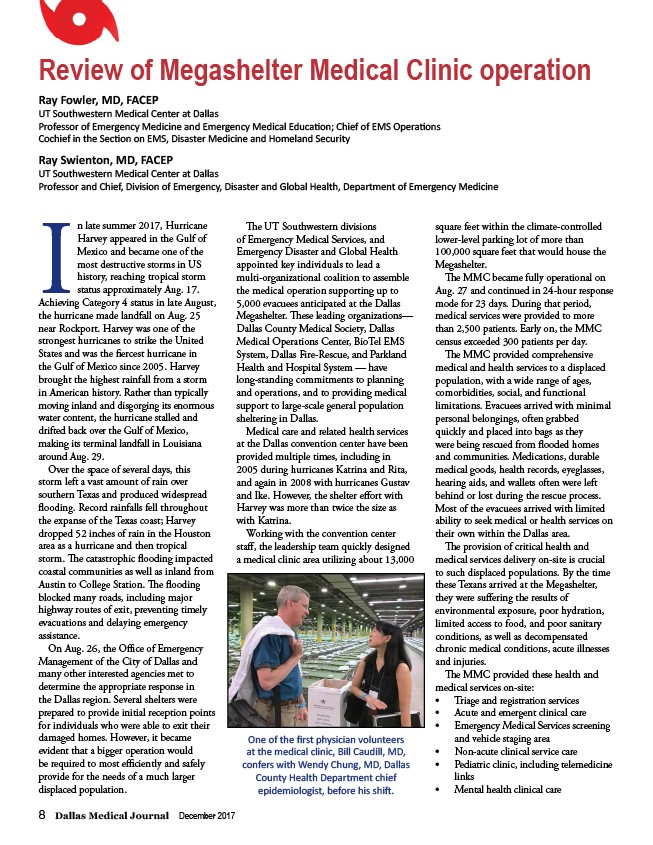
Review of Megashelter Medical Clinic operation
Ray Fowler, MD, FACEP
UT Southwestern Medical Center at Dallas
Professor of Emergency Medicine and Emergency Medical Educati on; Chief of EMS Operati ons
Cochief in the Secti on on EMS, Disaster Medicine and Homeland Security
Ray Swienton, MD, FACEP
UT Southwestern Medical Center at Dallas
Professor and Chief, Division of Emergency, Disaster and Global Health, Department of Emergency Medicine
n late summer 2017, Hurricane
Harvey appeared in the Gulf of
Mexico and became one of the
most destructive storms in US
history, reaching tropical storm
status approximately Aug. 17.
Achieving Category 4 status in late August,
the hurricane made landfall on Aug. 25
near Rockport. Harvey was one of the
strongest hurricanes to strike the United
States and was the fi ercest hurricane in
the Gulf of Mexico since 2005. Harvey
brought the highest rainfall from a storm
in American history. Rather than typically
moving inland and disgorging its enormous
water content, the hurricane stalled and
drifted back over the Gulf of Mexico,
making its terminal landfall in Louisiana
around Aug. 29.
Over the space of several days, this
storm left a vast amount of rain over
southern Texas and produced widespread
fl ooding. Record rainfalls fell throughout
the expanse of the Texas coast; Harvey
dropped 52 inches of rain in the Houston
area as a hurricane and then tropical
storm. Th e catastrophic fl ooding impacted
coastal communities as well as inland from
Austin to College Station. Th e fl ooding
blocked many roads, including major
highway routes of exit, preventing timely
evacuations and delaying emergency
assistance.
On Aug. 26, the Offi ce of Emergency
Management of the City of Dallas and
many other interested agencies met to
determine the appropriate response in
the Dallas region. Several shelters were
prepared to provide initial reception points
for individuals who were able to exit their
damaged homes. However, it became
evident that a bigger operation would
be required to most effi ciently and safely
provide for the needs of a much larger
displaced population.
8 Dallas Medical Journal December 2017
square feet within the climate-controlled
lower-level parking lot of more than
100,000 square feet that would house the
Megashelter.
Th e MMC became fully operational on
Aug. 27 and continued in 24-hour response
mode for 23 days. During that period,
medical services were provided to more
than 2,500 patients. Early on, the MMC
census exceeded 300 patients per day.
Th e MMC provided comprehensive
medical and health services to a displaced
population, with a wide range of ages,
comorbidities, social, and functional
limitations. Evacuees arrived with minimal
personal belongings, often grabbed
quickly and placed into bags as they
were being rescued from fl ooded homes
and communities. Medications, durable
medical goods, health records, eyeglasses,
hearing aids, and wallets often were left
behind or lost during the rescue process.
Most of the evacuees arrived with limited
ability to seek medical or health services on
their own within the Dallas area.
Th e provision of critical health and
medical services delivery on-site is crucial
to such displaced populations. By the time
these Texans arrived at the Megashelter,
they were suff ering the results of
environmental exposure, poor hydration,
limited access to food, and poor sanitary
conditions, as well as decompensated
chronic medical conditions, acute illnesses
and injuries.
Th e MMC provided these health and
medical services on-site:
• Triage and registration services
• Acute and emergent clinical care
• Emergency Medical Services screening
and vehicle staging area
• Non-acute clinical service care
• Pediatric clinic, including telemedicine
links
• Mental health clinical care
Th e UT Southwestern divisions
of Emergency Medical Services, and
Emergency Disaster and Global Health
appointed key individuals to lead a
multi-organizational coalition to assemble
the medical operation supporting up to
5,000 evacuees anticipated at the Dallas
Megashelter. Th ese leading organizations—
Dallas County Medical Society, Dallas
Medical Operations Center, BioTel EMS
System, Dallas Fire-Rescue, and Parkland
Health and Hospital System — have
long-standing commitments to planning
and operations, and to providing medical
support to large-scale general population
sheltering in Dallas.
M edical care and related health services
at the Dallas convention center have been
provided multiple times, including in
2005 during hurricanes Katrina and Rita,
and again in 2008 with hurricanes Gustav
and Ike. However, the shelter eff ort with
Harvey was more than twice the size as
with Katrina.
Working with the convention center
staff , the leadership team quickly designed
a medical clinic area utilizing about 13,000
One of the fi rst physician volunteers
at the medical clinic, Bill Caudill, MD,
confers with Wendy Chung, MD, Dallas
County Health Department chief
epidemiologist, before his shift .
I